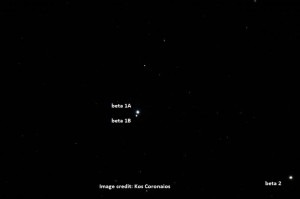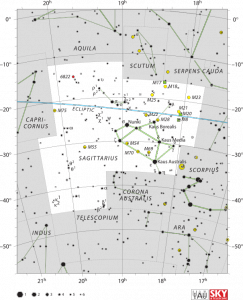September double star of the month – beta Sagittarii
by Dave Blane
In 1603 Johannes Bayer gave Greek letters to the stars in each constellation according to their apparent brightness but Sagittarius, however, does not follow this rule. The constellation’s brightest star, Kaus Austraulis, is Epsilon, while number two, Nunki, is of all things Sigma. The Alpha and Beta stars (Rukbat and Arkab), far to the south are only 15th and 16th brightest in the constellation!
Beta Sagittarii (or Akrab – Arabic for achilles tendon)is an optical double with two stars in the same line of sight that appear close together in the sky, but are actually a vast distance apart. The components are separated by 0.36 degrees which is slightly less than the apparent diameter of the Moon and so the pair make a fine naked eye double. Beta 1 Sgr (Arkab Prior) leads the way across the sky. It has a magnitude of 3.96 and is 378 light years from Earth. Beta 2 Sgr (Arkab Posterior) follows close behind, with a magnitude of 4.27 and is 137 light years from Earth. Beta 1 Sgr is a binary star discovered by Dunlop and has the discovery code DUN 226.
The primary, beta 1A is a spectral type B9 main sequence dwarf which has an apparent magnitude of +3.96 and beta 1B is a type A3 dwarf with an apparent magnitude of +7.4. The two stars are separated in the sky by about 28 arc-seconds, which puts them at least 3300 astronomical units apart (83 times Pluto’s distance from the Sun),so the orbital period must be at least 82 000 years.
In 2011 I measured the pair and found the separation to be 28.2” and the position angle 76.5o. Beta² Sagittarii is a spectral type F2 giant and has an apparent magnitude of +4.27.
So have a look at this bright naked eye double that is high in the southern sky in September and even a 60mm telescope will resolve the binary beta 1.
Finder chart for beta Sagittarii


